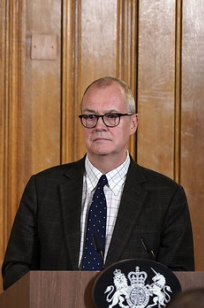Covid-19 update: 17 April
His concern was the failure to provide daily figures for care home deaths alongside those already released for hospitals. This was the only way to ‘understand the true scale of the spread’, he said.
The release of weekly deaths relating to Covid-19 by the Office for National Statistics provided both evidence for this point of view and showed the difficulties in putting it into practice. Of all deaths registered up to 3 April, where coronavirus was mentioned, 90% occurred in hospital, with the remaining 10% being in hospices, care homes and private homes.
The difficulty is the mismatch in timeframes between the different datasets. The hospital death figures are reported by hospitals on a daily basis and cover the UK. The ONS figures are for England and Wales and cover deaths both in and out of hospital. But they rely on the death being certified by a doctor, registered and processed, which can take days. It is further complicated by the ONS reporting both figures for deaths registered by a certain date and deaths up to a certain date, where registration didn’t happen until several days later.
The hospital figures clearly do not show the whole picture, but they remain important as an indicator of how the virus is progressing. Getting comparable figures on a daily basis – from tens of thousands of care homes not just from 200-odd NHS providers – would be a massive data collection needing to be started from scratch.
However the Department of Health and Social Care recognises the importance of providing a more holistic view of all deaths related to Covid-19. Its new action plan for adult social care – launched under the new CARE brand – says that from 10 April the Care Quality Commission has asked care providers to report suspected and confirmed Covid-related deaths.
Also in its action plan, the government committed to testing of all residents prior to admission to care homes – with this beginning with patients being discharged from hospital into care settings.
The ONS figures also showed that in the week to 3 April, the virus was linked to more than one in five of all deaths in England and Wales. And in a separate publication looking at deaths involving Covid-19 during March, it said that in 91% of the 3,912 deaths, the person had at least one pre-existing condition. Covid-19 was the third most frequent underlying cause of death in the month (although deaths have increased significantly in April).
However, the government has continued to point out that the numbers of deaths will be the last thing to respond to the introduction of social distancing measures, which were extended on Thursday for a further three weeks. The impact of the measures will first be seen in infection rates and hospitalisations.
Chief scientific adviser Sir Patrick Vallance told Thursday’s government briefing that there were encouraging signs of a positive impact, with new cases flattening and maybe even decreasing slightly. And the number of people in hospital beds – arguably the key early indicator – showed numbers decreasing across many regions. He said this was consistent with an assessment that the R0 value for the virus – representing the average number of people to which an infected person will transmit the virus – was now below 1, at least in the community. This did not mean it was below 1 in every setting – including hospitals and care homes – but overall this was a positive sign. The government refuses to be drawn on any exit plan – keen to ensure the public continues to respect the lockdown.
But others have started to think through the next steps and medium term for the NHS – and the challenge it might face once the peak of the Covid-19 outbreak is past.
NHS Providers this week produced a report examining the coronavirus story so far for the NHS since NHS leaders declared it a serious, level 4 incident at the end of January. But it also starts to explore the ‘new, post coronavirus NHS that trust leaders are determined should emerge from this crisis’.
It highlights numerous stories of frontline staff doing amazing things – a paediatric intensive care unit team moving their entire unit overnight to a different part of the hospital, for example, or a trust fitting an entire building with new oxygen piping and ducting in a week to ensure every bed could use a ventilator.
The sheer scale and speed of the transformation is impressive.
However, the report is also clear in identifying significant challenges – large levels of Covid-19-related staff absence on top of existing high vacancy levels, for example. And the report gives a detailed account of the problems – in some cases and for some pieces of kit these are real ongoing problems – with the supply of personal protective equipment.
The report also explores what trusts need now as the NHS approaches the initial peak of coronavirus-related demand and then briefly looks at what might happen beyond Covid-19. It said ‘there is a strong sense of “we should never go back”’.
The acceleration of digital transformation, with significant amounts of healthcare provision going online at record pace, is one area seen as a major positive that needs to be built on. The report also suggests that the response to the virus shows how integration of health and care can work when budgetary silos are ignored or bypassed.
The report identifies four important debates that will need to be held including one about capacity and funding. It argues that the NHS is one of the most efficient and best health services in the world. But both the NHS and social care have been running in ‘the red zone’ over sustainable capacity for some time.
It acknowledges the government’s commitment that the NHS will get whatever it needs to deal with the current challenge. ‘But if better funded health services with greater underlying capacity, like Germany, are able to weather coronavirus much better than the UK, then there will be understandable debate about the level of health and social care funding and how much capacity our health and care system really need,’ it said.
Related content
We are excited to bring you a fun packed Eastern Branch Conference in 2025 over three days.
This event is for those that will benefit from an overview of costing in the NHS or those new to costing and will cover why we cost and the processes.